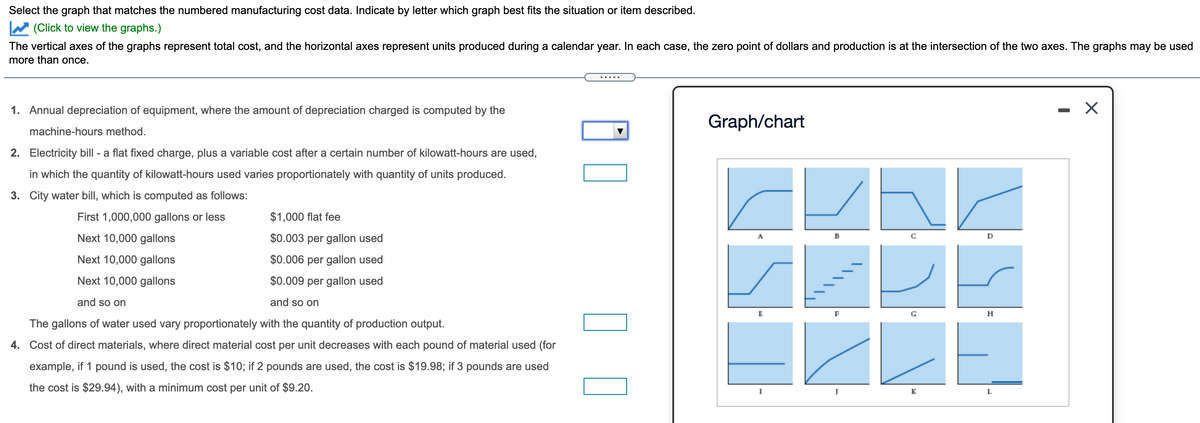Select the graph that matches the numbered manufacturing cost data. Indicate by letter which graph best fits the situation or item described. W (Click to view the graphs.) The vertical axes of the graphs represent total cost, and the horizontal axes represent units produced during a calendar year. In each case, the zero point of dollars and production is at the intersection of the two axes. The graphs m more than once. 1. Annual depreciation of equipment, where the amount of depreciation charged is computed by the - X Graph/chart machine-hours method. 2. Electricity bill - a flat fixed charge, plus a variable cost after a certain number of kilowatt-hours are used, in which the quantity of kilowatt-hours used varies proportionately with quantity of units produced. 3. City water bill, which is computed as follows: First 1,000,000 gallons or less $1,000 flat fee Next 10,000 gallons $0.003 per gallon used Next 10,000 gallons $0.006 per gallon used Next 10,000 gallons $0.009 per gallon used and so on and so on H The gallons of water used vary proportionately with the quantity of production output. 4. Cost of direct materials, where direct material cost per unit decreases with each pound of material used (for
Select the graph that matches the numbered manufacturing cost data. Indicate by letter which graph best fits the situation or item described. W (Click to view the graphs.) The vertical axes of the graphs represent total cost, and the horizontal axes represent units produced during a calendar year. In each case, the zero point of dollars and production is at the intersection of the two axes. The graphs m more than once. 1. Annual depreciation of equipment, where the amount of depreciation charged is computed by the - X Graph/chart machine-hours method. 2. Electricity bill - a flat fixed charge, plus a variable cost after a certain number of kilowatt-hours are used, in which the quantity of kilowatt-hours used varies proportionately with quantity of units produced. 3. City water bill, which is computed as follows: First 1,000,000 gallons or less $1,000 flat fee Next 10,000 gallons $0.003 per gallon used Next 10,000 gallons $0.006 per gallon used Next 10,000 gallons $0.009 per gallon used and so on and so on H The gallons of water used vary proportionately with the quantity of production output. 4. Cost of direct materials, where direct material cost per unit decreases with each pound of material used (for
Practical Management Science
6th Edition
ISBN:9781337406659
Author:WINSTON, Wayne L.
Publisher:WINSTON, Wayne L.
Chapter2: Introduction To Spreadsheet Modeling
Section: Chapter Questions
Problem 40P
Related questions
Question

Transcribed Image Text:Select the graph that matches the numbered manufacturing cost data. Indicate by letter which graph best fits the situation or item described.
W (Click to view the graphs.)
The vertical axes of the graphs represent total cost, and the horizontal axes represent units produced during a calendar year. In each case, the zero point of dollars and production is at the intersection of the two axes. The graphs may be used
more than once.
1. Annual depreciation of equipment, where the amount of depreciation charged is computed by the
Graph/chart
machine-hours method.
2. Electricity bill - a flat fixed charge, plus a variable cost after a certain number of kilowatt-hours are used,
in which the quantity of kilowatt-hours used varies proportionately with quantity of units produced.
3. City water bill, which is computed as follows:
First 1,000,000 gallons or less
$1,000 flat fee
Next 10,000 gallons
$0.003 per gallon used
B
Next 10,000 gallons
$0.006 per gallon used
Next 10,000 gallons
$0.009 per gallon used
and so on
and so on
E
The gallons of water used vary proportionately with the quantity of production output.
4. Cost of direct materials, where direct material cost per unit decreases with each pound of material used (for
example, if 1 pound is used, the cost is $10; if 2 pounds are used, the cost is $19.98; if 3 pounds are used
the cost is $29.94), with a minimum cost per unit of $9.20.
I
K
Expert Solution
This question has been solved!
Explore an expertly crafted, step-by-step solution for a thorough understanding of key concepts.
This is a popular solution!
Trending now
This is a popular solution!
Step by step
Solved in 2 steps

Recommended textbooks for you

Practical Management Science
Operations Management
ISBN:
9781337406659
Author:
WINSTON, Wayne L.
Publisher:
Cengage,

Practical Management Science
Operations Management
ISBN:
9781337406659
Author:
WINSTON, Wayne L.
Publisher:
Cengage,